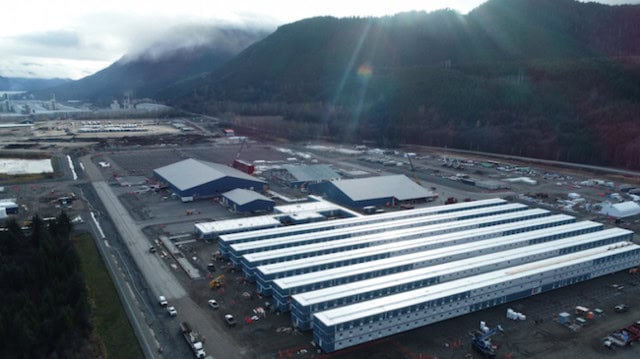
1,000 workers on site preparing for Kitimat LNG terminal
One year ago, the partners behind LNG Canada formally sanctioned a $40 billion project in Kitimat.
Today, roughly 1,000 workers are on site – and that’s just to set the stage for the main construction phase, which isn’t expected to start for another couple of years.
“It’s definitely buzzing,” says Kitimat Mayor Phil Germuth. “The hotels are full, there’s another brand new hotel that’s being built. There’s a brand new 35-unit townhouse development being done.”
Located at the mouth of Douglas Channel, next to the recently upgraded Rio Tinto aluminum smelter, the LNG Canada site at 400 hectares is about the size of 550 soccer fields.
At the north end, the Cedar Valley Lodge, a self-contained work village that will house up to 4,500 workers, is starting to take shape, while at the south end, dredging barges are busy scooping up sediment – some of it contaminated from historical industrial activities – to deepen the channel for liquefied natural gas carriers. The dredging alone currently employs about 150 workers.
In between these two bookends is the main site, where a battalion of more than 70 pieces of earthworks machinery – dump trucks, graders, excavators – has already moved about one-third of the 2.8 million cubic metres of fill needed to prepare the site.
On site are 6,000 40-metre steel pilings, made in Turkey. They will be driven into the ground to support the LNG complex, which will include two LNG processing modules, known as trains.
In July 2021, LNG modules that will be built in Asia are expected to arrive. That is when most of the tradespeople – electricians, welders, pipefitters – will be mobilized to start putting it all together. Peak construction will be between 2022 and 2024.
“That’s when the skyline of the project changes every day, virtually,” said LNG Canada general manager Vince Kenny, who spent the last five years on an LNG project in Australia. “It’s quite an intense couple of years.”
From 2022 to 2024, up to 7,500 people will be employed on the project. The shifts will be staggered, with employees working two weeks on and one week off, so no more than 4,500 will be on site at any one time. Another 2,500 will be working on the associated $6.2 billion Coastal GasLink project.


